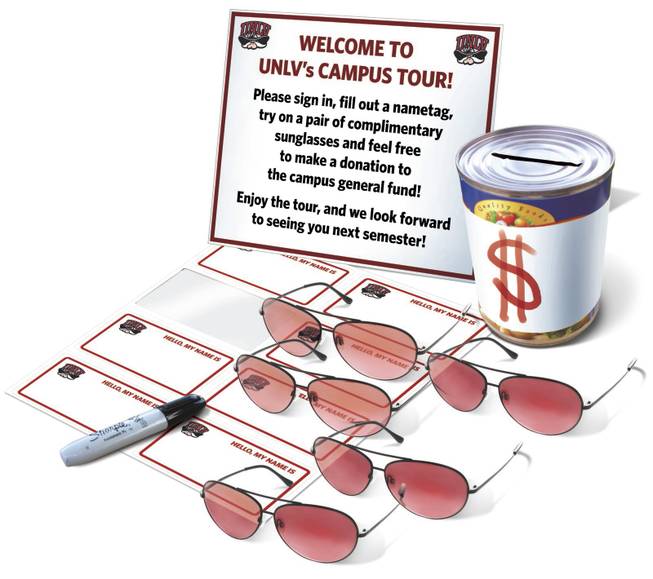Thursday, July 17, 2008 | 2 a.m.
Sun Archives
- Web site shows how UNLV hit by budget cuts (7-15-2008)
- Budget cuts worry veteran prof, give newbie pause (7-13-2008)
- Next budget expected to be cut to the bone (7-9-2008)
- Budget crisis has UNLV slashing staff (6-30-2008)
Beyond the Sun
Related Documents
This is what Jim Rogers wants you to know about UNLV: The university will offer about 500 fewer classes this school year. Nearly 100 employees recently learned they were losing their jobs, many due to budget cuts. And if you need further proof that these are dire times, please take note that the institution will stop emptying office trash baskets daily.
Rogers, chancellor of Nevada’s public college system, reported on this scrimping in a memo last week. Administrators hope this portrayal of UNLV — skeletal, rawboned — will help convince legislators and other power brokers that the university can’t afford to lose more funding.
But this gaunt, uncomely incarnation of UNLV is unlikely to score points with another important audience — prospective students and their parents.
“Obviously, it’s a bad sell point,” said Faustina Tran, a junior and a campus tour guide.
So recruiters lock the gloomy, starving UNLV in the proverbial closet as they peddle a cheerier image of their school.
UNLV boasts small classes, an outstanding honors college and a wide variety of extracurricular activities, even a rock-paper-scissors club, Tran and a fellow tour guide told a group of about 20 people on a Saturday morning campus walk-through. In short, students here can look forward to a promising future.
Never mind that in a memo Rogers’ office sent to the press last month, UNLV Executive Vice President and Provost Neal Smatresk wrote: “UNLV remains committed to offering its students a world class education, but its ability to deliver the dream is in serious jeopardy.”
A 4.5 percent cut to higher education funding this biennium “was a nightmare in and of itself!” Smatresk continued. The governor has asked the university system to plan to slash another 14 percent in the next biennium, which, for UNLV, would be “FATAL,” Smatresk wrote.
You’d think it would be a challenge for recruiters to stay positive while daily headlines, and memos from their own administration, blare the state’s ever-deepening financial crisis.
As it turns out, though, budget problems haven’t led tour guides to change much about the way they market UNLV. They typically don’t talk about the budget quagmire unless someone asks about it, which, apparently, doesn’t happen often.
“Nobody asks about the budget cuts at all,” Tran said.
“We haven’t had a lot of questions,” agreed Suzanne Espinoza, associate vice president for enrollment and student services. “I actually asked that question of the recruitment staff and the tour guides, and they say that no one has asked that question.”
“UNLV has a lot to offer students ... And we would hate for that message to get lost in discussions about the budget, which we hope will be a short-term issue,” said Espinoza, noting that officials have worked hard to preserve the quality of academic programs.
Espinoza said she doesn’t know why visitors don’t have more questions about the school’s financial woes.
But one reason seems to be that many prospective students, like current ones, are oblivious to budget problems. Take Kayla Tate, 17, a Valley High School graduate who plans to attend UNLV this fall.
“All I did was look up what the dorm rooms were like and the classrooms and stuff like that,” said Tate, who took Tran’s tour Saturday. “I didn’t look into any of the budget cut things that were going on.”
“I know that they’re cutting a few things in high school and middle school and elementary school ... That’s all I really know,” said Tate, who added she doesn’t read local papers but peruses Internet news sites and sometimes watches TV newscasts.
Applicants curious about budget reductions can find relevant information without UNLV’s help, Tate said. But recruiters, she added, should speak up about any cuts that might prevent students from graduating in a timely manner.
In Tate’s case, knowing more about the state’s finances probably wouldn’t have made a difference. She said she had her “heart set” on UNLV because it’s affordable and close to home.
Tran would encourage anyone who queried her about the budget to research the issue “and think about the effects that it has on our education system,” she said.
For her part, Tran said selling UNLV has been easy despite the university’s not-so-rosy financial picture.
“It hasn’t been a difficult job for me,” the kinesiology student said. “I feel like there’s so much more that we can talk about (about) our campus and our university.”
So on Saturday’s tour she and fellow guide Kelsey Morozow chattered away about UNLV’s gems — a young but respected law school, a swank new recreation center, sports programs (the football team “kind of sucks,” allowed Morozow, a junior studying dance, but games “are still really fun”).
Each visitor got a folder filled with promotional materials touting UNLV’s rapid growth in recent years. Photos of smiling students pepper brochures trumpeting the school’s academic programs, facilities and research.
No need to scare anyone with information from UNLV’s other public relations campaign.
After all, morsels like these, from Smatresk’s memo on what could happen if UNLV lost 14 percent of its state funding, really wouldn’t be selling points:
“The subsequent losses of classes, and the resulting loss of students would begin a ‘death spiral’ of declining services and funding that could never be reversed.”


Join the Discussion:
Check this out for a full explanation of our conversion to the LiveFyre commenting system and instructions on how to sign up for an account.
Full comments policy